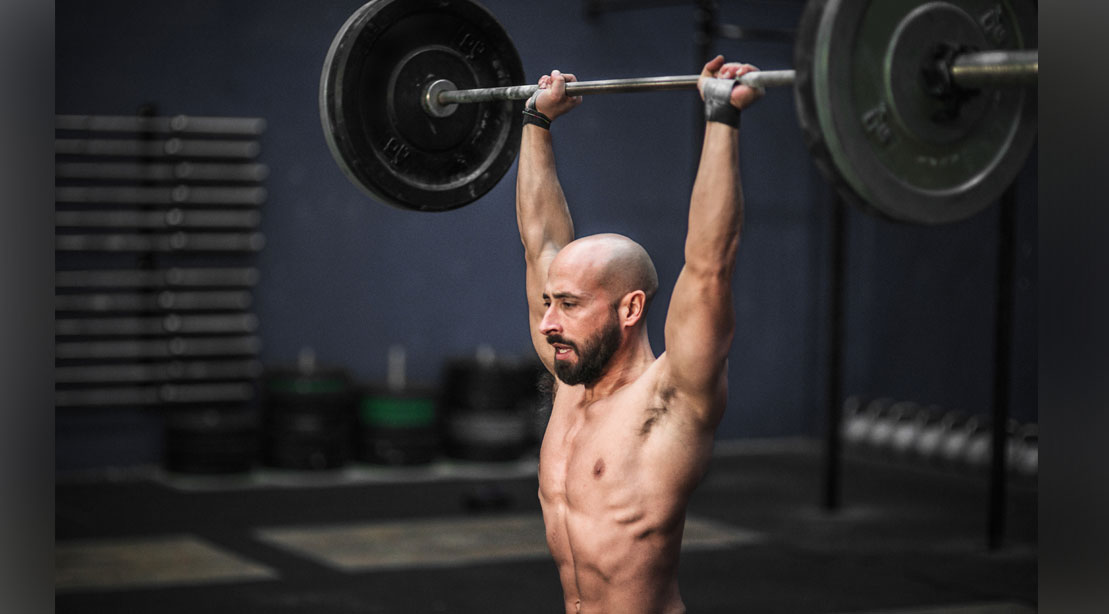The strict overhead press is the gold standard when it comes to overhead pressing. Using nothing more than your upper body you press a barbell strictly overhead with no help from your lower body. There’s no doubt strict overhead press is a fantastic exercise for strength and mass and requires extreme amounts of core strength and shoulder mobility to make it happen. But unfortunately, not everyone has the mobility and strength to do this with good technique. Plus, besides the gym when do you find yourself strictly lifting or throwing anything overhead? Probably not much and that’s why the push press is a better alternative for the majority of lifters.
This article will explain what the push press is, muscles trained, benefits of the push press, technique tips, programming tips, and some variations and alternatives.
WHAT IS THE PUSH PRESS?
The barbell push press uses a lower-body dip, think quarter squat with knees going over toes to push the barbell overhead. This is not two movements but one seamless movement. You use your lower body to press the barbell overhead. The push press uses a triple extension of the ankles, knees, and hips, which closely mimics what a lot of overhead athletes do and most sports that involve running.
HOW TO DO THE PUSH PRESS
- Start by assuming the same front-rack positioning as the front squat and have your wrist and shoulders aligned with a shoulder-width grip.
- Keep an upright upper body as dip downward about four to six inches, driving your knees over your toes.
- Then pushing your upper body through the barbell and using the quads and glutes forcefully drive yourself while pushing the barbell overhead till lockout,
- Slowly lower down the barbell to the starting position and reset and repeat.
MUSCLES TRAINED BY THE PUSH PRESS
The push press needs lower- and upperbody muscles to work together to press the barbell explosively overhead. Here are the main upper and lower body muscles trained by the push press.
Lower-Body Muscles
- Quads: The knee dip and knee extension gives you the oomph you need to press the barbell overhead
- Glutes: Near the end of the drive phase, you need hip extension to press the barbell overhead and keep the back in neutral as you approach lockout.
- Anterior & Posterior Core: A strong midsection allows for the transfer of power between the lower and upper body. Plus, it helps keep your spine neutral under the compressive load of the barbell.
Upper-Body Muscles
- Deltoids: The anterior and lateral diploid help press the barbell overhead the posterior deltoid stabilize the shoulder joints when the barbell is overhead
- Upper Pecs: Assists the deltoids in pressing the barbell overhead.
- Triceps: Kick in during the final third of the movement to achieve lockout.
BENEFITS OF THE PUSH PRESS
The combination of using your lower and upper body allows you to press great loads overhead to improve your power, strength, and muscle all within one exercise. Does it get any better than this?
- Improves the bench press and other overhead exercises: Being able to lift more weight overhead will help improve your bench press because they involve similar muscles. This will improve other overhead exercises like single-arm presses, carries, and even the strict overhead press. Plus, if you’re an Olympic lifter the push press is a great accessory exercise for building more overhead strength. The push press trains hip and leg drive which is similar to the Olympic lifts and trains, dip-and-drive mechanics of the legs similar to jerks and the ability to dip to the correct depth for every lift and jerk
- Total-body strength and muscle: Using a triple extension to press the barbell overhead provides strength and muscle-building stimulus to your quadriceps and glutes. Plus, lifting pressing more weight overhead compared to the strict press helps build bigger shoulders and triceps.
- Builds hip drive and athletic power: Hip and leg drive used in the push press are crucial factors to improve locomotion activities such as running, sprinting, and jumping. The stronger you are the bigger your potential for speed. The push presses transfer of power from the lower to the upper body is similar to what a lot of overhead athletes do on the sporting field, making this a great exercise for most overhead athletes.
PROGRAMMING SUGGESTIONS
The push press is a full-body explosive and powerful exercise that requires a ton of energy and focus. For this reason, it needs to be performed early in your training after your warmup. Even performing a few light push presses before hitting the heavier weight will grease the groove and set the table for better form.
Here are a few suggestions for programming the push press for strength or muscle.
- Absolute Strength: Training between 85 to 90% of your 1RM performing 1-3 reps works well here. Keep the total rep count low between 10 to 15 reps. For an extra challenge, doing one to three reps every minute on the minute for five to 10 minutes allows rep out with a heavy load.
- Muscle building: Muscle is built in all set and rep ranges but because of the push presses technical nature, stress on the spine, and lifting heavy weights overhead, performing six to 12 reps at 80% works well here.
PUSH PRESS VARIATIONS AND ALTERNATIVES
If you need to get strong overhead the push press is the perfect exercise for you, But not everyone has the required, shoulder mobility, power, and core stability to pull off the barbell push press. Here are a couple of variations and alternatives to safely train the overhead movement.
